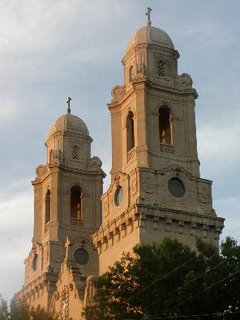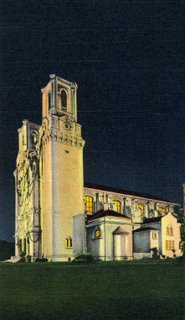 701 N 40th Street St. Cecilia's Roman Catholic Cathedral
701 N 40th Street St. Cecilia's Roman Catholic CathedralBuilding Permit: 1905
Building Style: Spanish Renaissance Revival
Architect: Thomas Kimball
Thomas Rogers Kimball began the design of this Spanish Resaissance Revival edifice in 1901, sited on land once considered West Omaha and though a poor choice for a new cathedral. The interior accommodates an enormous barrel vaulted ceiling with adorned molded ribs, supported by a series of double arched bays. The impressive eight "singing" stained glass windows in the clerestory and may of those along the ambulatory were created by the Boston artist Charles J. Connick. The central focus of the cathedral is the apse(area of the alter);, with its altar of white Carrara marble and bronze "Christus". The Christ and the bronze Station of the Cross were crafted by Albin Polasek of Czechoslovakia, as well as th six carved mahogany statues of the "doctors of the church" in the pulpit, and five of the relief figures of the apostles in the wall of the sanctuary. The sanctuary wood is oak, and adorned by the Bishop's chair, screen and clerical stalls.
Kimball designed the pulpit and confessionals, which were then hand carved in Pietrasanta, Italy. In the Chapel of Our Lady of Nebraska, the stained glass windows were reassembled from a 16th century Spanish church.Kimball died 25 years prior to the consecration of the
 cathedral (1959), but the finishing details, including the towers, were completed to the very inch that Omaha's most renowned architect had specified. An extremely careful and demanding restoration of the cathedral began in 1997, first with the replacement of the roof's red tiles with tiles of the same era, furthered by the recreation of the original sun-gilded canvas mural of the apse ceiling, and much master stenciling and painting work throughout the church. In 2003, Marin Pasi Organ Builders of Roy, Washington, and Kristian Wegscheider of Dresden, Germany, built a new pipe organ for the cathedral. This resonant instrument sensitively includes the arches and pillars as well as other ornamentation designed by Kimball from the original 1918 organ facade. A new alter made of bronze and incorporating two types of marble, by local sculptor John Laiba was completed in 2005. Supplementary restoration work continues.
cathedral (1959), but the finishing details, including the towers, were completed to the very inch that Omaha's most renowned architect had specified. An extremely careful and demanding restoration of the cathedral began in 1997, first with the replacement of the roof's red tiles with tiles of the same era, furthered by the recreation of the original sun-gilded canvas mural of the apse ceiling, and much master stenciling and painting work throughout the church. In 2003, Marin Pasi Organ Builders of Roy, Washington, and Kristian Wegscheider of Dresden, Germany, built a new pipe organ for the cathedral. This resonant instrument sensitively includes the arches and pillars as well as other ornamentation designed by Kimball from the original 1918 organ facade. A new alter made of bronze and incorporating two types of marble, by local sculptor John Laiba was completed in 2005. Supplementary restoration work continues.